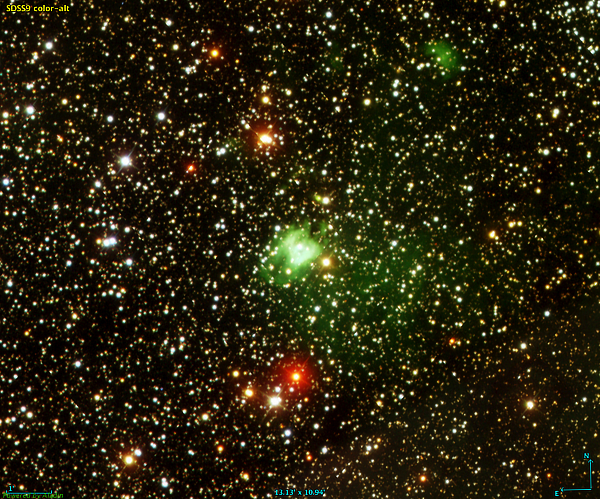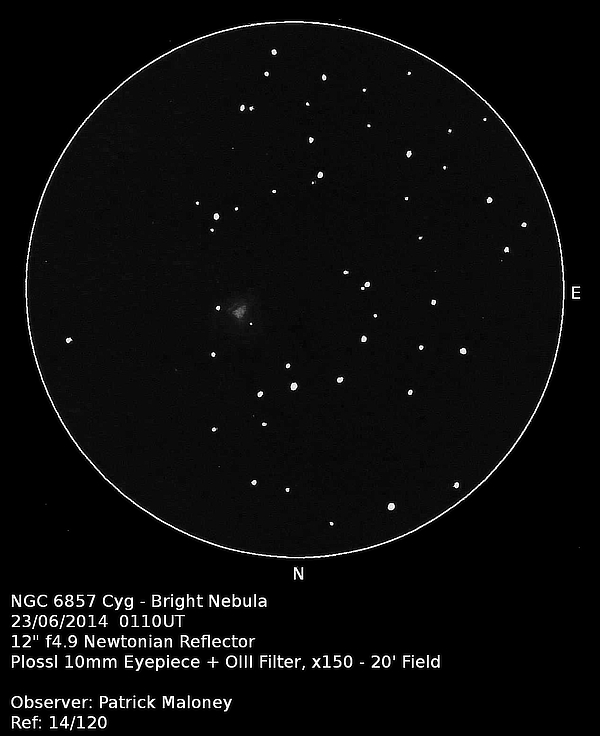NGC 6857 in Cygnus
July 2024 - Nebula and Cluster of the Month
Cygnus rides high in the sky during July nights. The Milky Way, as it runs down through the body of the swan, is packed with myriad deep-sky wonders. Open clusters, planetary nebulae and bright nebulae (emission and reflection) abound.
This month we’re going to look at one of the lesser-known objects. It can be considered as a brighter knot in the masses of swirling gaseous nebulae that wreath the centreline of the constellation.
NGC 6857 was first catalogued by William Herschel, who found it on the night of 5 September 1784. He placed it in his third category (very faint nebulae) and gave it the catalogue number 144 H.III. He described it that night as Some extremely faint stars with nebulosity. Irregularly extended.
The field is indeed scattered with many faint stars, a fairly typical Milky Way background. Herschel may have believed there was some connection between his ‘extremely small stars’ and the nebulosity. This seems to have been refuted by the time the object made it into the NGC (1888) where its description reads Faint, amongst Milky Way stars.

This little patch of brighter nebulosity sits amongst many knots and swirls of nebulae, with a bewildering number of designations. NGC 6857 is the brightest spot in the nebula known as Sh2-100, which in turn is part of a larger complex called GN 19.59.6. NGC 6857 itself once bore the planetary nebula designation PK 70+1.2, though this has now been expunged from the catalogue, as it has been definitively shown to be an emission nebula and not a planetary.
The Revised New General Catalogue of 1973 maintains its reputation as an unreliable source by listing the object unequivocally as a planetary nebula.
This does give a clue to its appearance, though. Through the eyepiece it is easy to believe that this is a small planetary nebula, similar to many others in the area.
In the Night Sky Observer’s Guide: Volume 2 – Spring & Summer by Kepple and Sanner, descriptions of the visual appearance of the object are given for 8—10” telescopes at x75 and for 12—14” telescopes at magnification x125. Both use the word ‘faint’, and seem more concerned with the distribution of small stars around the object. The entry for the 12—14” telescope finishes with ‘The nebula rather resembles a planetary.’
Parameters for this object are very thin on the ground. Even that massive repository of astronomical data, the Deep Sky Field Guide to Uranometria 2000.0, although it lists the nebula, gives no parameters at all for it. I have only ever seen one magnitude for it, and that was 11.4. This agrees with my experience of the object, and I’m happy to quote that. As to its size, my measurements suggest that this triangular object is about 40” long on its longest side.
NGC 6857 can be found slightly to the east of the centre point of the line joining γ Cygni (Sadr) and β Cygni (Albireo) or 1.9° southeast of η Cygni (magnitude 3.9). Be prepared to do some hunting. It’s not always immediately obvious. An OIII or UHC filter can help – adding to the earlier confusion about its true classification.

I observed it in June 2014, on a strongly twilit night, but with no moon. The sky was very bright and pretty blue, near white at low altitudes. If I can see it under those conditions, you have to be in with a good chance.
On that night, I found NGC 6857 to be fairly bright. It was visible to direct vision even without the OIII filter in place. The filter improved the visibility of the nebula and revealed more of it. It appeared as a triangular smudge apparently leading away from an 11th magnitude star. The middle is brighter and also triangular.
This is another under-observed object, and is worth a few moments of your time.
| Object | RA | Dec | Type | Magnitude |
|---|---|---|---|---|
| NGC 6857 | 20h 01m 48s | +33° 31’ 30” | HII Region | 11.4 |